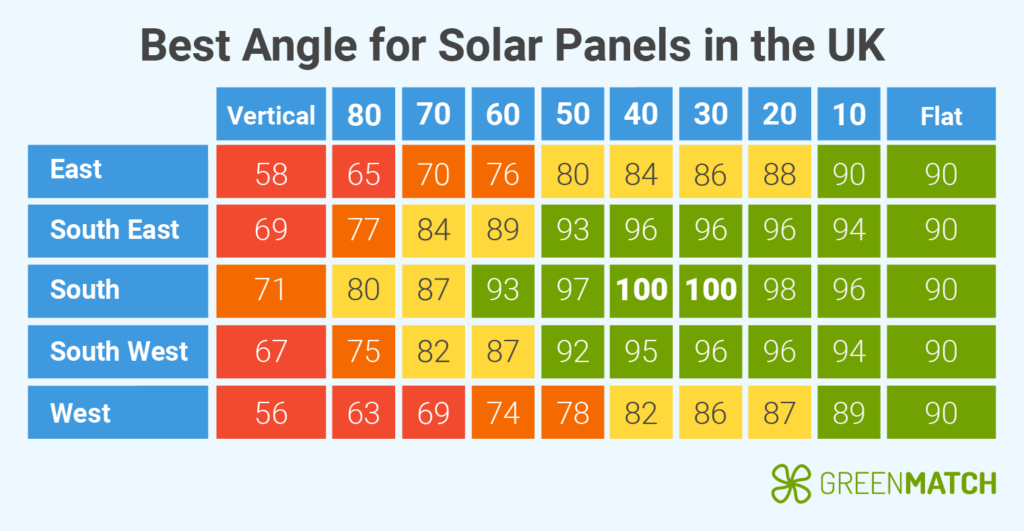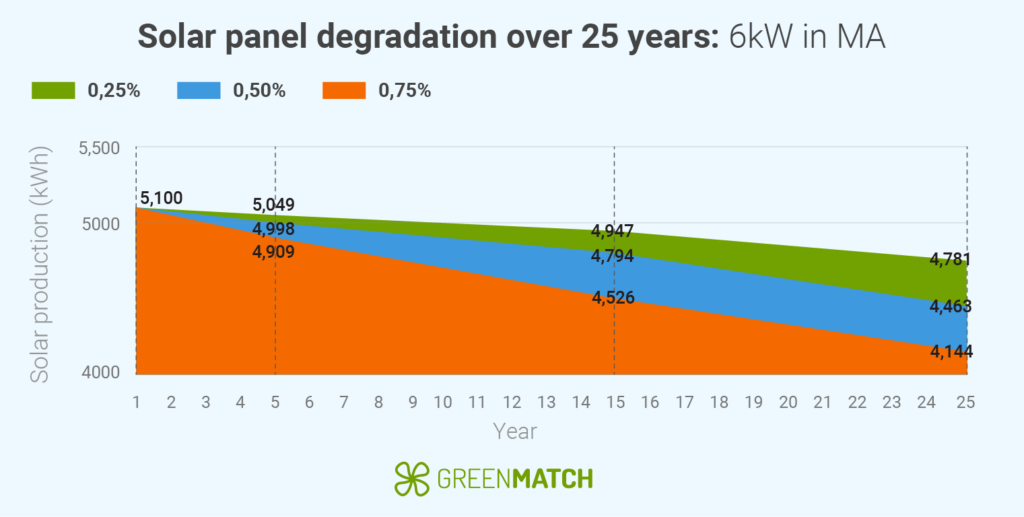- GreenMatch
- Solar Energy
- Solar Panels
- Solar Panel Calculator
Solar Panel Calculator UK: Calculate Costs, Savings, & Output

- Our calculator can help you determine the ideal size of solar panels for your home and calculate your energy and carbon savings.
- Most homes will need a 4kW system, which is suitable for the average 2 to 3-bedroom house.
- Kilowatt-peak (kWp) is the on-paper output of a solar panel system under ideal conditions, while kWh refers to energy provided by one kilowatt of power for one hour.
Calculating solar panel costs, savings, and energy output can be a bit complex, considering several variables. That's why we've created our solar panel calculator, a user-friendly tool designed to help you quickly estimate what solar panel system is right for you, its cost, and how much you can save by installing solar panels on your home.
Just enter a few details about your property and energy consumption, and you'll receive tailored results that make the process simple and straightforward.
Our solar panel calculator can give you a great overview of solar panel costs and savings in the UK. However, the cost and savings of solar panels will be affected by potential extras and installation costs, which vary by installer.
That’s why, if you want to get precise numbers, you should consult an installer. Finding a trustworthy one can lead to significant savings and an adequate installation, but this can take hours of research. Luckily, our service can save you time and money using our network of vetted installers. You can easily receive up to 4 free quotes from installers in your area.
All you have to do is click the button below and fill out a 30-second form to get started.
- Quotes from local engineers
- Payment by finance available
- Save up to £1,567 per year
It only takes 30 seconds



- How does the calculator work, and how can you use the results?
- How do I calculate the number of solar panels needed for my home?
- How much energy will my solar panels produce?
- How do I determine the optimal angle and direction for my solar panels?
- What is the estimated cost and return on investment (ROI) for a solar panel system?
- How do I calculate the correct battery size for my solar panel system?
- How do I account for solar panel degradation and efficiency in long-term output calculations?
- FAQ
How does the GreenMatch solar calculator work?
Our solar panel calculator will need your location, roof details, energy consumption, system preferences, financial information, and additional factors to estimate solar panel size, cost, and savings. Here’s how it calculates each metric:
- Number of solar panels needed: The solar calculator considers your available roof space and energy consumption to determine the optimal number of panels. It factors in standard panel dimensions and efficiency ratings to maximise energy production within your available area.
- Annual solar energy output: Using your location's sunlight measurement data and the proposed system size, the solar panel kWh calculator estimates your yearly kilowatt-hours (kWh) production. It accounts for factors like panel efficiency, roof orientation, and typical weather patterns.
- Total cost of installation: The solar cost calculator estimates installation costs based on current market prices for panels, inverters, and other components. It also affects average labour costs for your area and system size.
- Savings on your energy bill: The calculator projects your potential annual savings by comparing your current energy consumption and costs with the estimated solar energy production. It considers factors like electricity rates and any applicable feed-in tariffs.
- Payback period: The calculator determines how long it will take for your energy savings to offset the initial installation costs. It takes into account projected energy price increases and panel degradation over time.
If, after using our solar panel calculator, you’re still wondering how many solar panels you need or if solar panels are worth it, we highly recommend speaking to a solar specialist who can give you tailored advice. Moreover, it’s important to get multiple quotes from different installers (usually 3 or 4), so you can adequately compare prices.
It’s important to note that we use numbers specific to solar panel cost calculators in the UK. Other countries may need different dimensions, specs, and outputs.
How do I calculate the number of solar panels needed for my home?
To calculate the number of solar panels you need:
- Check your electricity bill or your electricity company's app/portal. You need to find your consumption in kilowatt-hours (kWh) per year.
- Determine how much power one solar panel will produce by converting the Watt output into kWh. This will depend on how many sunlight hours you receive and the output of the individual panel.
- Calculate how many panels you need by dividing your annual consumption (kWh) with annual production per panel (kWh).
Keep in mind that you don't necessarily need to cover your entire consumption. Many homeowners will cover 60-80% and use the grid as a backup.
Most homes will need between 6 and 10 solar panels for a 3kW or 4kW system. These systems are suitable for 2 to 3-bedroom homes, which is the most common house size in the UK.
| System size | House size | Number of panels (400W) | Number of panels (500W) |
|---|---|---|---|
| 2kW | 1 to 2 bedrooms | 5 | 4 |
| 3kW | 2 to 3 bedrooms | 7 | 6 |
| 4kW | 2 to 3 bedrooms | 10 | 8 |
| 6kW | 4 to 5 bedrooms | 15 | 12 |
How many solar panels you need will vary based on the kW per panel, your home’s energy demand, and how much roof space you have. Solar panels come in a variety of sizes, most commonly between 400W and 500W.
How much energy will my solar panels produce?
The exact amount of energy your solar panels produce will vary depending on how well they are placed, their power output, and the sunlight hours in your area.
| System size | Annual energy production | Best for |
|---|---|---|
| 2kW | 1,700kWh | 1-2 bedrooms |
| 3kW | 2,550kWh | 1-2 bedrooms |
| 4kW | 3,400kWh | 2-3 bedrooms |
| 6kW | 5,100kWh | 4-5 bedrooms |
These days, the best solar panels have about 500W or more. Similarly, good solar panels tend to have efficiencies higher than 23% as a benchmark. These will ensure a higher energy output, along with a decent degradation rate (0.2% after the first year is a decent rate). These stats ensure a long-lasting and powerful system.
How do I determine the optimal angle and direction for my solar panels?

The optimal angle and direction for solar panels is 30° to 50° on a southward-facing roof. A few other directions can also suffice, but this will provide the optimal output closest to the kWp rating.
Since the Earth's angle and orientation relative to the sun change throughout the year, it is best to adjust solar panels for optimal light capture within this range. Similarly, panels outside of this range will suffer from bad angling in certain months as the sun veers away.
It’s wise to reangle your solar panels every few months to help keep them at an optimal angle. This can add 10% to 20% more output, annually depending on where you live and how much sunlight you receive.
In most Northern Hemisphere countries, south-facing roofs are the most appropriate. While other angles, like a westward or eastward direction, may suffice, they will not be the best option. For flat roofs, homeowners can get ballasts and solar panel stands that they can angle and position for ideal sunlight capture.
What is the estimated cost and return on investment (ROI) for a solar panel system?
The average cost of solar panels in the UK is roughly £6,600 - £8,100, which can produce an ROI of £19,000 - £21,000.
| House size | Solar system size | System cost | Average electricity consumption (annual) | Annual savings | ROI |
|---|---|---|---|---|---|
| 1-2 bedrooms | 3kW | £5,700 - £7,000 | 1,800kWh | £783 | £13,000 - £15,000 |
| 2-3 bedrooms | 4kW | £6,600 - £8,100 | 2,700kWh | £1,304 | £19,000 - £21,000 |
| 2-3 bedrooms | 5kW | £8,300 - £10,200 | 2,700kWh | £1,304 | £24,000 - £26,000 |
| 4-5 bedrooms | 6kW | £10,000 - £12,200 | 4,100kWh | £1,567 | £29,000 - £31,000 |
The payback period will be between 7 and 6 years, for these systems. This will depend on how many savings you have compared to your energy consumption and the cost of the system. You can decrease the total cost and payback period by applying for grants for solar panels or getting a solar loan from a financing company.
It’s important to remember that the costs listed above are estimates. You can check out our calculator to get an estimate of the prices for your home and in your area. Another way to obtain more accurate information is to consult professional installers and get solar quotes.
Finding reliable installers is crucial for finding the best prices. Rather than wasting hours calling up companies and requesting prices, you can use our service. We have a network of installers we’ve personally vetted, ensuring you get the best prices. Click the button below, fill out a 30-second form, and we’ll get back to you with up to 4 free, non-binding quotes.
- Quotes from local engineers
- Payment by finance available
- Save up to £1,567 per year
It only takes 30 seconds



How do I calculate the correct battery size for my solar panel system?
While our calculator does not add the price for a solar battery, it is recommended to get one that suits your system (even though it’s not an absolute necessity). Deciding on the best solar battery for your home is similar to determining what size your solar panels need to be: it’s all about matching your home’s energy consumption with your needs.
| House size | Solar panel system size | Battery size |
|---|---|---|
| 2 to 3 bedrooms | 3kW | 6 - 7kWh |
| 2 to 3 bedrooms | 4kW | 9 - 10kWh |
| 3 to 4 bedrooms | 5kW | 11 - 12kWh |
| 4 to 5 bedrooms | 6kW | 13 - 14kWh |
Buying a battery storage for solar panels alongside your system can ensure off-grid performance and save additional money. Solar batteries can be programmed to store energy for use during off-peak hours, which can allow them to save between £1 to £5 every day.
How do I account for solar panel degradation and efficiency in long-term output calculations?
Solar panel degradation can decrease the amount of energy your panels will generate over time, so it can be crucial to keep account of this in the long term. Along with the level of efficiency, the overall output will decrease. Here’s an example using a 6kW system:

As you can see, every year the panel loses more output. The degradation rate shows how much efficiency it loses per year, meaning there will be slightly less output over time. Good solar panels tend to have a degradation rate between 0.25% and 0.5% after the second year, which gives them the ability to thrive for far longer.
With an annual degradation rate of 0.75, the panels will probably not be able to power the whole house after year 25 (even under optimal conditions). That’s why it’s best to choose your panels wisely.
This effect can be curbed by getting panels with low annual degradation rates, which many solar panel companies will list on their specs sheets. Companies often provide a warranty that covers against excessive dips in solar panel performance for a number of years (up to 12). In this regard, you should look for a decent warranty as well.
Solar panels are worth it if you can balance the right characteristics and specifications for your home. This is why you should talk to a reliable installer who can provide you with the best panels at a reasonable price. Finding one on your own can take quite a few hours, and even then, you won’t be sure you’re getting the help you need. That’s where our service comes in.
Simply fill out a 30-second form, and we’ll get back to you with up to 4 free, non-binding quotes from reliable installers. Click the button below to get started.
- Quotes from local engineers
- Payment by finance available
- Save up to £1,567 per year
It only takes 30 seconds



Frequently asked questions
To calculate how many solar panels you need, compare your home’s energy output with the kW rating of a solar panel system. Higher kW solar systems will cost more and take up more space.
The payback time of solar panels can be calculated by dividing their annual savings by their cost, which gives you the years required for payback. More costly systems will thus have a higher payback time.
You can calculate the solar energy a system will generate by multiplying the sunlight hours in your area by the average hourly generation. The effectiveness of solar panels can vary based on region and season, so it’s best to keep this in mind.

Alejandro is a copywriter at GreenMatch and is passionate about European environmental policy and renewable energy. He has conducted research on the European Green Deal’s impact on EU energy policy and climate adaptation, and he is committed to using his writing skills to promote sustainable policies.

We strive to connect our customers with the right product and supplier. Would you like to be part of GreenMatch?

- How does the calculator work, and how can you use the results?
- How do I calculate the number of solar panels needed for my home?
- How much energy will my solar panels produce?
- How do I determine the optimal angle and direction for my solar panels?
- What is the estimated cost and return on investment (ROI) for a solar panel system?
- How do I calculate the correct battery size for my solar panel system?
- How do I account for solar panel degradation and efficiency in long-term output calculations?
- FAQ
Stay up to date with energy saving tips and grant alerts
Receive offers, marketing and promotions via email from Leads.io about GreenMatch and our brands/partners to help you save.
Thank you for subscribing to our newsletter!
Your email has been successfully added to our list. We look forward to sharing our latest updates with you soon!
